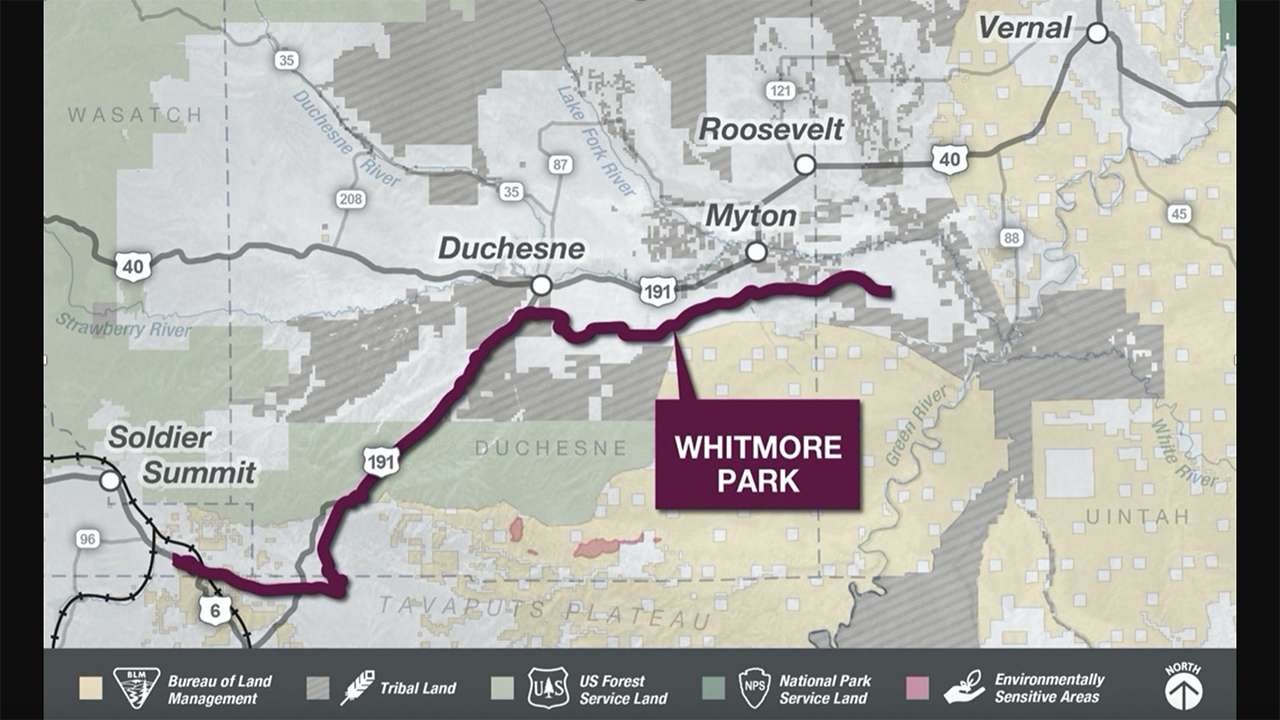
Small-Road Briefs: Uinta Basin Railway, G&W
Written by Carolina Worrell, Senior Editor
In August 2021, the STB Office of Environmental Analysis issued a Final EIS for the Uinta Basin Railway project, identifying the 88-mile Whitmore Park Alternative as the environmentally preferred route, one of three analyzed. It would extend from two terminus points in northeastern Utah’s Uinta Basin near Myton and Leland Bench to a connection with the existing Union Pacific Provo Subdivision near Kyune (see map above).
The U.S. Forest Service pulls a right-of-way permit that would have allowed construction of the Uinta Basin Railway. Also, Genesee & Wyoming (G&W) issues its latest Environmental, Social and Governance (ESG) Report.
Uinta Basin Railway
The U.S. Forest Service on Jan. 17 withdrew its approval of a right-of-way permit that would have allowed the construction of a railroad project through about 12 miles of roadless, protected forest in Utah, according to an Associated Press (AP) report.
According to the report, the decision affecting the Ashley National Forest follows a U.S. Court of Appeals ruling in August that struck down “a critical approval” involving the proposed Uinta Basin Railway, an 88-mile railroad line that would connect oil and gas producers in rural Utah to the broader rail network, allowing them to “access larger markets and ultimately sell to refineries near the Gulf of Mexico.”
“It’s a victory for the Colorado River and nearby communities that would be threatened by oil train accidents and spills, and for residents of the Gulf Coast, where billions of gallons of oil would be refined,” said Ted Zukoski, an attorney at the Center for Biological Diversity, one of several groups that has sued over the project, according to the AP report.
In the August ruling, the Washington, D.C.-based appeals court decided that a 2021 environmental impact statement and opinion from the federal Surface Transportation Board (STB) were “rushed and violated federal laws.” It sided with environmental groups and Colorado’s Eagle County, which had sued to challenge the approval, according to the AP report.
According to the report, the court said the board had engaged in only a “paltry discussion” of the environmental impact the project could have on the communities and species who would live along the line—as well as the “downline” communities who live along railroads where oil trains would travel.
“The limited weighing of the other environmental policies the board did undertake fails to demonstrate any serious grappling with the significant potential for environmental harm stemming from the project,” the ruling stated.
The Forest Service’s decision Wednesday to withdraw its approval, AP reports, was based on the U.S. Court of Appeals ruling, but Ashley National Forest Supervisor Susan Eickhoff said the agency “could issue a new decision if deficiencies in the environmental impact statement are addressed.”
If approved, the railroad would “let producers, currently limited to tanker trucks, ship an additional 350,000 barrels of crude oil daily on trains extending for up to two miles,” according to the report.
G&W
G&W on Jan. 17 announced that it has issued its latest ESG Report (download below), summarizing the company’s initiatives for full-year 2022.
Among the highlights:
- “G&W developed a greenhouse gas (GHG) emissions inventory to help track progress toward achieving its science-based emissions reduction target.
- “The company continued to upgrade its North American locomotive fleet to reduce fuel consumption and minimize emissions, while also pilot testing alternative fuels in the U.S. and United Kingdom.
- “G&W established employee engagement groups around the topic of organizational communication and identified specific ways to better ensure that all employees—from corporate support to frontline roles – have equal access to company information.
- “Underscoring G&W’s commitment to safety, more than 300 railroad employees received individual recognition for working more than 20 years injury-free, while nearly 1,800 safety audits were conducted to ensure safe practices across multiple physical working environments.
- “G&W earned its highest-ever overall customer satisfaction score in a survey to over 1,400 customers covering 2022-2023, demonstrating the company’s commitment to effectively serve its customers and help local communities thrive.”
“We’re proud of the progress we have made toward fulfilling our ESG goals,” said G&W North America CEO Michael Miller. “Creating a more sustainable future for ourselves, our customers and our communities is rooted in several of G&W’s Core Values and, moving forward, will be paramount to achieving our Core Purpose.”



